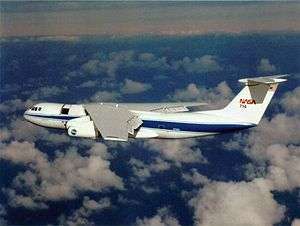Kuiper Airborne Observatory
| KAO | |
|---|---|
 | |
| The KAO in flight. | |
| Other name(s) | Kuiper Airborne Observatory Gerard P. Kuiper Airborne Observatory |
| Type | Lockheed C-141A Starlifter |
| Manufacturer | NASA |
| Construction number | 6110[1] |
| Registration | N714NA |
| Serial | NASA 714 |
| Owners and operators | NASA |
| In service | 1974-1995 |
| Preserved at | Moffett Field[2] |
| Role | Airborne observatory |
| Status | Retired |
| Developed from | Lockheed C-141 Starlifter |
 The telescope for KAO | |
| Organization | NASA |
|---|---|
| Coordinates | 37°25′17″N 122°02′51″W / 37.4214649°N 122.047412°WCoordinates: 37°25′17″N 122°02′51″W / 37.4214649°N 122.047412°W |
|
| |
The Gerard P. Kuiper Airborne Observatory (KAO) was a national facility operated by NASA to support research in infrared astronomy. The observation platform was a highly modified Lockheed C-141A Starlifter jet transport aircraft (s/n: 6110, registration: N714NA,[1] callsign: NASA 714[1]) with a range of 6,000 nautical miles (11,000 km), capable of conducting research operations up to 48,000 feet (14 km).
Aircraft
The KAO was based at the Ames Research Center, NAS Moffett Field, in Sunnyvale, California. It began operation in 1974 as a replacement for an earlier aircraft, the Galileo Observatory, a converted Convair 990 (N711NA), that was destroyed in a collision with a U.S. Navy Lockheed P-3C Orion patrol aircraft in 1973.[3]
Telescope
The KAO's telescope was a conventional Cassegrain reflector with a 36-inch (91.5 cm) aperture, designed primarily for observations in the 1 to 500 μm spectral range. Its flight capability allowed it to rise above almost all of the water vapor in the Earth's atmosphere (allowing observations of infrared radiation, which is blocked before reaching ground-based facilities), as well as travel to almost any point on the Earth's surface for an observation.
History
The KAO made several major discoveries, including the first sightings of the rings of Uranus in 1977 and a definitive identification of an atmosphere on Pluto in 1988. The KAO was used to study the origin and distribution of water and organic molecules in regions of star formation, and in the vast spaces between the stars. Kuiper astronomers also studied the disks surrounding certain stars that may be related to the formation of planetary systems around these stars. It took infrared spectrum measurements of the planet Mercury in 1995.[4] No quartz or olivine in Mercury's surface rocks was detected.[4]
Peering still deeper into space, KAO astronomers studied powerful far-infrared emissions from the center of our galaxy and other galaxies. Scientists on board the KAO tracked the formation of heavy elements like iron, nickel, and cobalt from the massive fusion reactions of supernova SN 1987A.


The KAO was retired in 1995 and is viewable at Moffett Field, although it is no longer airworthy.[2] It has been succeeded by a Boeing 747-based airborne observatory equipped with a larger aperture telescope, the Stratospheric Observatory for Infrared Astronomy (SOFIA). SOFIA completed its first test flight on April 26, 2007[5] and its telescope saw first light on May 26, 2010.[6] Initial "routine" science observation flights began in December 2010[7] and the observatory is slated for full capability by 2014 with about 100 flights per year.[8][9]
See also
References
- 1 2 3 http://www.c141heaven.info/dotcom/domeier/domeier.html
- 1 2 Ogden, Bob (2011). Aviation Museums and Collections of North America (2 ed.). Tonbridge, Kent: Air Britain (Historians) Ltd. p. 161. ISBN 978-0-85130-427-4.
- ↑ Aviation Safety Network http://aviation-safety.net/database/record.php?id=19730412-1
- 1 2 Malcolm W. Browne - An Airborne Telescope Risks a Look At Mercury (1995) - The New York Times
- ↑ "SOFIA Airborne Observatory Completes First Test Flight". USRA. 2007-04-26.
- ↑ "SOFIA Sees Jupiter's Ancient Heat : Discovery News". News.discovery.com. 2010-05-29. Retrieved 2012-03-10.
- ↑ "News and Updates". Sofia.usra.edu. Retrieved 2012-03-10.
- ↑ Keller, Luke; Jurgen Wolf (October 2010). "NASA's New Airborne Observatory". Sky and Telescope: 22–28.
- ↑ Hautaluoma, Grey; Hagenauer, Beth (2008-01-16). "SOFIA Completes Closed-Door Test Flights". NASA. Retrieved 2008-07-23.
External links
| Wikimedia Commons has media related to Kuiper Airborne Observatory. |
- About the Kuiper Airborne Observatory
- Infrared Astronomy: The Kuiper Airborne Observatory
- Live from the Stratosphere
- The Compact Cosmic Ray Telescope aboard the Kuiper Airborne Observatory
- Kuiper Airborne Observatory Marks 30th Anniversary of its Dedication
- NASA’s Kuiper Airborne Observatory, 1971–1995:An Operations Retrospective With a View to SOFIA nasa.gov